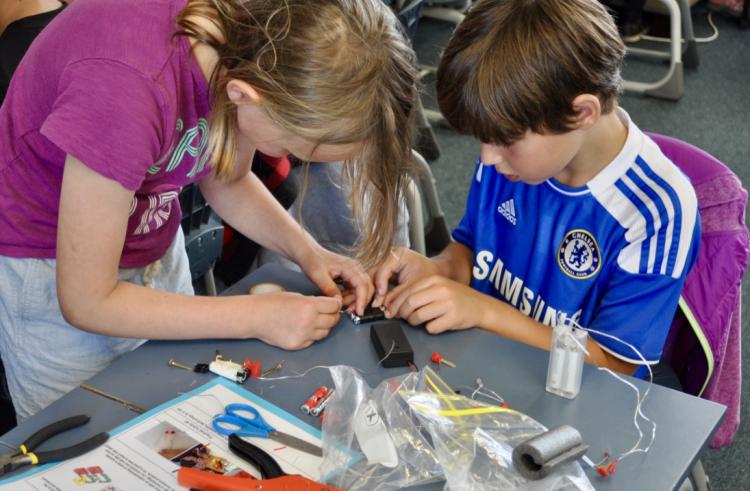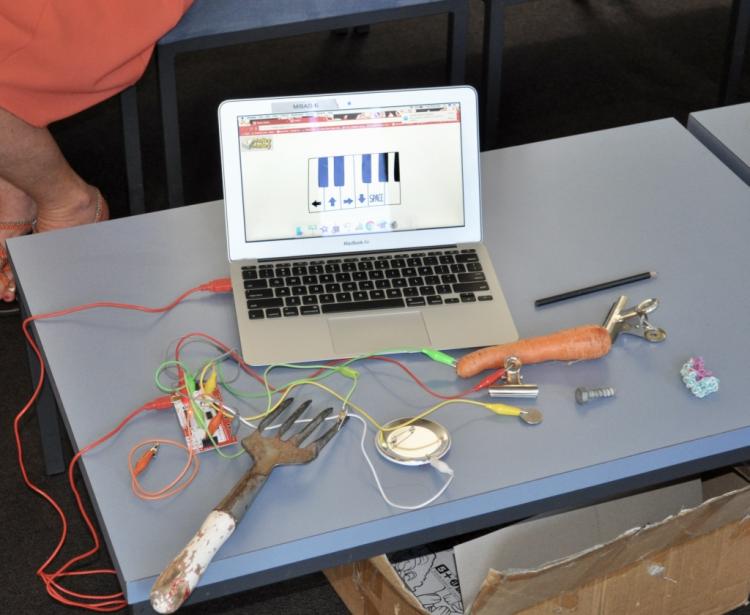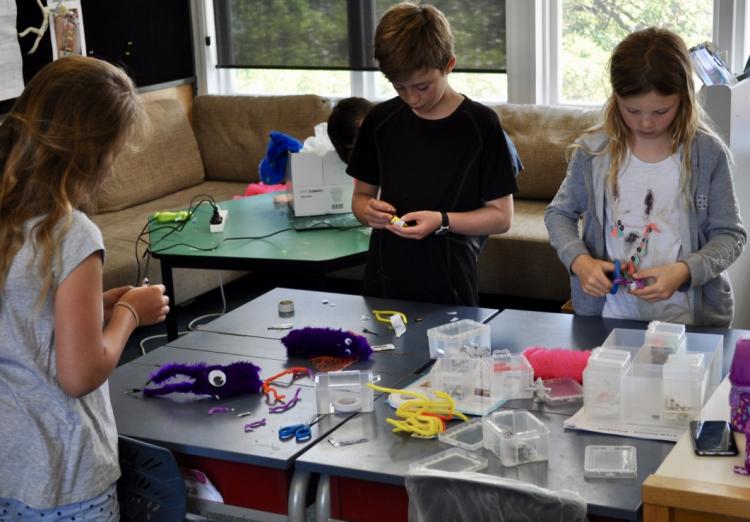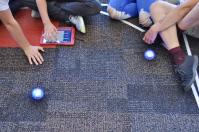STEM learning at Muritai School
Tags: Mathematics and statistics | Science | STEM/STEAM | Technology | Primary |
In 2015, Muritai School incorporated the idea of becoming a STEM school into their Towards 2020 vision.
After consulting the school community and Board of Trustees, a strong feeling emerged that a focus on STEM education was necessary to equip Muritai School students for the future.
What is STEM learning?
STEM focuses on science, technology, engineering, and mathematics. STEM programmes approach these subjects in an integrated way, rather than teaching them separately. STEM learning incorporates a blend of hands-on learning activities and online learning applications to solve real-world problems.
More information »
- Ten trends 2017: STEM – CORE Education
"I think it's opening our eyes and the students' opportunities are evolving at a rate that we couldn't even have imagined because of our focus in this area."
– Bec Power, Principal
Leading STEM learning
Since 2015, professional development sessions focused on building capacity in a range of STEM-related subjects, such as:
- 3D printing
- robotics
- coding
- construction
- engineering challenges
- science lessons.
When Bec Power arrived as Principal in 2017, she wanted to draw on the progress made and take it further.
"Prior to my arrival some pockets of expertise and leadership were developed. This year we've worked to broaden that and develop further development for every staff member so that they're all starting on their STEM journey."
– Bec Power, Principal
Professional development
A significant portion of professional development at Muritai has been devoted to STEM learning:
- A dedicated STEM classroom gives staff a chance to try things.
- Drawing on staff expertise and interests to find "STEM leaders" was a way of developing a STEM culture.
- Jamie Power (Associate Principal/e-learning Leader) led "coffee and computer" sessions around robotics and coding.
- Staff are given time to ask questions and share knowledge in PD sessions.
"When you grow something into a school, we don't cross our fingers and hope that it goes well, so we continue our focus by bringing it into part of our teaching and learning pathway (our appraisal system) and in 2017, everyone had a STEM focussed growth goal."
– Bec Power, Principal
"We have lots of fun and hands-on PD and giving teachers activities. Yesterday afternoon we had a fantastic staff PD session getting their hands on the technology and seeing what they could do and getting them excited about it so that was quite important."
– Melissa Coton, STEM leader
Community support
Capitalising on Eastbourne's tight community, Muritai school keeps locals involved through publicised events, a school blog and a newsletter giving regular updates on school highlights and student achievements. This has yielded a number of benefits for STEM learning at the school, including:
- involvement and support from parents in the after-hours "make club"
- donations of equipment, such as a 3D printer, from local businesses
- donated PD for staff and students from local experts and parents around coding and 3D printing.
STEM in the classroom
Creating a STEM hub
To facilitate STEM learning, a dedicated STEM room was created:
- Each syndicate has an allocated day a week and each classroom uses the space once a week.
- Activities and/or equipment is on-hand and can be set up for multiple users during the day.
- Work in progress can be stored safely on shelves until the next session.
- Students use this space for different STEM activities including science lessons, making things, 3D printing, robotics, coding, construction, and engineering challenges.
Tools and equipment
When purchasing tools for STEM learning, start with learning goals and decide which tools and materials will best help achieve those goals.
Bec suggests keeping the tech sustainable by purchasing robotics, tools, and tech that is interchangeable, will talk to each other, and work together.
STEM projects
Finding authentic audiences
Jamie Power (Associate Principal/e-learning Leader) always looks for opportunities to take his students' work beyond the classroom and share it with an authentic audience so that students understand their value as experts and possessors of important new skills and knowledge.
His students have found authentic audiences by:
- posting the video games they've made onto games communities, where they are played and reviewed by other gamers and coders
- documenting their work in Multi-Touch Books and sharing them with parents and other STEM learners via iTunes
- sharing their knowledge of coding and giving professional development to people from Te Aho o Te Kura Pounamu – The Correspondence School in Wellington
- an inquiry into fudge – students made fudge, packaged it, promoted it, and sold it around the local community in order to raise funds for the Wellington free ambulance. They planned a budget to resource the project and documented their work using video.
"Sharing that knowledge, and experiences that we've had, and projects, and, you know, all the good stuff that we're doing, we don't just want to keep it here, we want to share it and celebrate with other people, and get our information out there."
– Jamie Power, Associate Principal/e-learning Leader
Coding and computational thinking
Scaffolding coding with young learners
STEM leader, Barbara Ryan takes a scaffolded approach to teaching coding. Junior students develop their computational thinking practice using coding cards. During these sessions, they have demonstrated growth in their ability to apply logical thinking and directionality. Junior teachers have noticed a growth in some students’ ability to follow and give directional instructions.
Juniors at Muritai begin their journey into computational thinking using a hands-on approach. The next step is applying what they've learnt to coding apps on the iPad, such as Scratch Junior and Bee-Bots.
Coding cards
Learn code with Sphero
Sphero is an effective way for students to start learning to apply computational thinking and coding skills.
By coding directional commands that automate the Sphero's movement, students grasp the basic principles of coding, which they can then apply to more sophisticated problems and contexts, such as using Scratch and Python to create apps and games.
"We’ve done a lot of coding in the Scratch platform, etc. which is brilliant but can sometimes be a little bit artificial. This [Sphero] is more hands-on and they are actually seeing the application for what they’re doing. And just the engagement, I can see that they’re all excited about technology. We had visits to WelTec, looking at their School of Engineering and you could see the guys making connections with things we’ve learnt in class and being really excited and kind of seeing themselves in those roles as well. 'Hey I could be an engineer, that’s something I could do'."
– Melissa Coton, STEM leader
Reflecting on Sphero
Student outcomes
Following the renewed focus on STEM learning at Muritai School, teachers and leaders observed:
- higher motivation and engagement in STEM learning
- an enthusiastic uptake of 21st-century skills and knowledge
- an increase in the number and diversity of student-directed projects and agentic learning opportunties
- a disposition of innovation and outside-of-the-box thinking among students
- a growth in collaboration and collaborative work
- examples of students continuing STEM-related learning and projects at home and elsewhere
- increased engagement from the community and participation in the learning of the students.
"We want the children to have some sort of agency. I think choice is big. You look around the room and I think out of the 27 kids that are here, we've got probably about six or seven things going on in class and they all seem to know what they're doing. So agency is having that choice in what they want to do and how they want to do it."
– Jamie Power, Associate Principal/e-learning Leader



